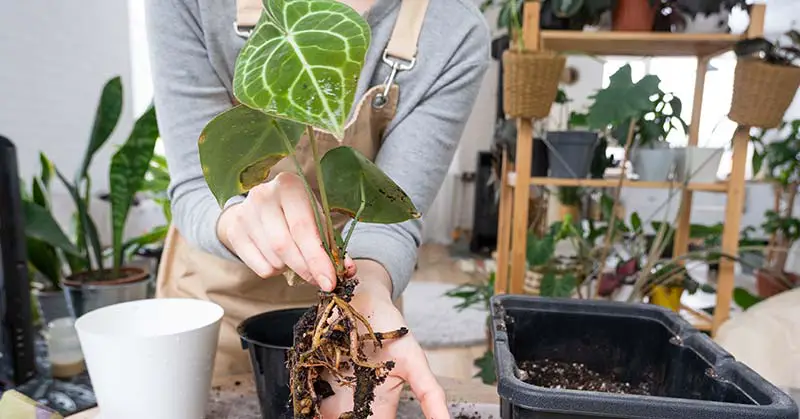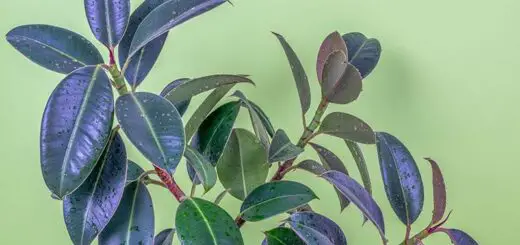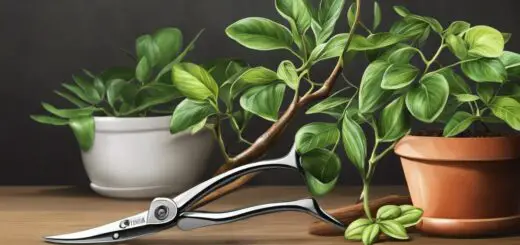Anthurium Care in Gardening: Tips and Techniques
Anthurium care: Anthuriums, commonly known as Flamingo Flowers, Tail Flower, or Laceleaf, are perennial plants native to the tropical rainforests of Central and South America. They are a part of the Araceae family, known for its large variety of species — over 1000.
The genus Anthurium is known for its vibrant, glossy, heart-shaped flowers that add a touch of exotic beauty to any environment. These “flowers” are spathes — modified leaves — in various colors, including red, pink, salmon, pale yellow, green, and multicolored. The actual flowers are found on the spadix, the spiky part that protrudes from the spathe.
Anthuriums have become popular houseplants due to their striking appearance and relatively low maintenance requirements. They can bloom all year round with the proper care, adding a splash of color and a tropical feel to indoor spaces.

Importance of proper Anthurium care
Taking care of Anthurium plants properly is crucial for several reasons:
1. Health and Longevity:
Like all living things, Anthuriums have specific needs that must be met to thrive. By providing the correct care, you can help your plant live a long, healthy life and bloom consistently throughout the year.
2. Aesthetic Appeal:
Anthuriums are known for their stunning, exotic appearance. Their glossy leaves and vibrant spathes can add a pop of color and a touch of the tropics to any space. However, these plants can lose their luster if not cared for properly. Their leaves can turn yellow or brown, and they may stop producing flowers.
3. Prevention of Diseases and Pests:
Proper Anthurium care also involves regularly checking for signs of pests or diseases. Many common plant problems can be avoided or minimized by maintaining the right conditions and promptly addressing any issues.
4. Improved Air Quality:
Like many houseplants, Anthuriums are believed to help purify the air. In addition, they can absorb certain toxins, helping to improve the indoor air quality of your home or office. However, a poorly cared for plant may need to perform this function more effectively.
5. Psychological Benefits:
Caring for plants, including Anthuriums, can have psychological benefits. Nurturing a plant can provide a sense of accomplishment, reduce stress, and improve mood. Moreover, a thriving, blooming Anthurium can bring joy and a sense of satisfaction.
Key Requirements for Anthurium Care
Caring for an Anthurium requires understanding its native environment—tropical rainforests—and replicating those conditions as closely as possible in your home. Here are the key elements to consider:
A. Light:
Anthuriums prefer bright, indirect light. Direct sunlight can burn the leaves, while too little light can lead to leggy growth and few if any, flowers. A north or east-facing window is ideal. If that’s not available, you can also use fluorescent lights.
B. Water:
Anthuriums prefer to be dry enough. Therefore, they should be watered thoroughly but allowed to dry out almost before watering again. A good rule of thumb is to water when the top inch of soil feels dry. Overwatering can lead to root rot, a common problem with these plants.
C. Temperature:
Being tropical plants, Anthuriums prefer warm temperatures. They thrive in temperatures between 70°F and 90°F. They can tolerate a minimum of 60°F, but anything below this can lead to poor growth and potential damage to the plant.
D. Humidity:
High humidity is key for Anthuriums. They thrive in environments with 60-70% humidity. You can increase humidity by placing the plant on a tray filled with pebbles and a little water, misting the plant regularly, or using a humidifier.
Soil and fertilizer needs for Anthuriums
Soil:
Anthuriums prefer well-draining, airy soil to prevent waterlogging and root rot. They thrive in a mixture that mimics their natural rainforest environment, rich in organic matter but also loose and porous.
A good potting mix for Anthuriums might include peat moss or coconut coir (for moisture retention), perlite or orchid bark (for aeration), and a bit of compost or worm castings (for added nutrients).
Some people also successfully grow Anthuriums in sphagnum moss or a mix designed for orchids.
Fertilizer:
Anthuriums are not heavy feeders but benefit from regular fertilization during the growing season (spring and summer). A balanced, water-soluble houseplant fertilizer, diluted to half strength, can be used every 4-6 weeks.
Alternatively, you can use a fertilizer specifically designed for flowering plants with a higher phosphorus (P) content to promote blooms. Always follow the manufacturer’s instructions when applying fertilizer.
When the plant’s growth slows in fall and winter, you should reduce fertilization or stop it altogether. Over-fertilization can lead to salt buildup in the soil, harming the plant’s roots and leading to brown leaf tips.
Remember to constantly water your Anthurium thoroughly after fertilizing to help distribute the nutrients and prevent the roots from getting burned by the fertilizer.
Monitor your plant’s response to fertilization and adjust as necessary. Yellowing leaves, for example, can indicate that the plant is getting too much fertilizer. On the other hand, if the plant’s growth seems sluggish during the growing season, it might benefit from more feeding.
Pruning and repotting Anthuriums
Pruning Anthuriums:
Pruning an Anthurium mainly involves removing dead or dying leaves and flowers to keep the plant neat and healthy and prevent disease spreading.
Here’s a simple process for pruning:
- Use clean, sharp scissors or pruning shears. Sterilize the blades before and after use to prevent the spread of diseases.
- Cut off any yellow or brown leaves at the base where they connect to the main stem.
- Remove faded or brown flowers in the same way. This also encourages the plant to produce more blooms.
- If your Anthurium has become leggy (i.e., long stems with few leaves), you can trim back the stems to promote bushier growth.
Remember to prune sparingly and avoid removing more than one-third of the plant at a time.
Repotting Anthuriums:
Anthuriums generally need to be repotted every 2-3 years, or when the plant becomes root-bound (i.e., the roots take up more than half of the pot or start growing out of the drainage holes).
Here are the steps to repot your Anthurium:
- Choose a new pot that’s 1-2 inches larger in diameter than the current one. Ensure it has good drainage.
- Prepare a suitable potting mix (described in the previous section about soil needs).
- Carefully remove the Anthurium from its current pot. Brush off any old soil from the roots.
- Place the plant in the new pot, spreading out the roots gently. The plant should be at the same depth it was before.
- Fill around the roots with the new potting mix, pressing down lightly to remove any air pockets.
- Water thoroughly and place the pot in a warm, bright location out of direct sunlight.
Repotting can be stressful for a plant, so it’s best to do it in late winter or early spring when the plant is about to enter a period of vigorous growth. After repotting, give your Anthurium time to adjust before resuming routine care.
Dealing with pests and diseases
Anthuriums, like all plants, can be affected by pests and diseases. Here’s how to identify and deal with the most common ones:
1. Pests:
Aphids, Mealybugs, and Scale: These pests can be identified by the sticky residue on leaves or nearby surfaces. They can cause yellowing leaves and stunted growth. Treat by wiping the leaves with a cloth soaked in soapy water or using an insecticidal soap.
In severe infestations, a systemic insecticide may be required.
Spider Mites: These tiny pests can cause speckling on the leaves and fine webs. They thrive in dry conditions, so increasing humidity can help prevent them. If infested, you can use a miticide or wipe the plant down with soapy water.
2. Diseases:
Root Rot: Overwatering can lead to root rot, a fungal disease. Symptoms include yellowing leaves, wilting, and a general decline in plant health. If you suspect root rot, you’ll need to remove the plant from the pot, trim off any soft, brown roots, and repot in fresh, well-draining soil.
Bacterial Blight and Fungal Leaf Spot: These diseases can cause spots on the leaves. They’re usually due to high humidity and poor air circulation. Improving these conditions can help prevent these diseases. Affected leaves should be pruned off. If the problem persists, use a suitable fungicide or bactericide.
Propagating Anthuriums
Anthuriums can be propagated through several methods. The most common and easiest way is through division, which involves separating a part of the plant with roots attached and planting it in a new pot. Here’s a step-by-step guide to propagating Anthuriums through division:
1. Choose the Right Time: Spring or early summer is the best time for propagation as the plant is entering a period of active growth.
2. Prepare Your Materials: You’ll need a clean, sharp knife or shears, a pot with drainage holes, and fresh, well-draining potting mix. You may also want to have some rooting hormone, although it’s unnecessary.
3. Remove the Parent Plant from Its Pot: Carefully remove the Anthurium from its pot, ensuring not to damage the roots. Loosen the root ball gently with your fingers to separate the roots.
4. Identify a Section to Divide: Look for a section of the plant with at least one stem and several roots attached. This will become your new plant.
5. Make the Division: Cut the identified section from the main plant using your clean knife or shears. Try to ensure that the division has a good amount of roots attached to give it the best chance of survival.
6. Plant the Division: Fill your new pot with the potting mix and plant the division at the same growing depth. Firm the soil around the roots and water thoroughly.
7. Care for the New Plant: Place the new plant in a warm, bright location out of direct sunlight and care for it like a mature Anthurium. It may take a few weeks for the new plant to establish itself and start new growth
Final Thoughts
Anthuriums are captivating plants with striking, heart-shaped blooms and glossy green foliage. Their exotic charm can bring a touch of the tropics to any indoor space.
Although native to the rainforests of Central and South America, they can thrive in your home, blooming throughout the year with the right care and attention.
Understanding and providing the appropriate lighting, watering, temperature, and humidity conditions are vital to keeping your Anthurium healthy.
Regularly checking for pests and diseases, providing the right soil mix and nutrients, and knowing when and how to prune or repot, are also integral parts of Anthurium care.
With patience and care, these plants can offer an enriching gardening experience, purify indoor air, and provide psychological benefits.



